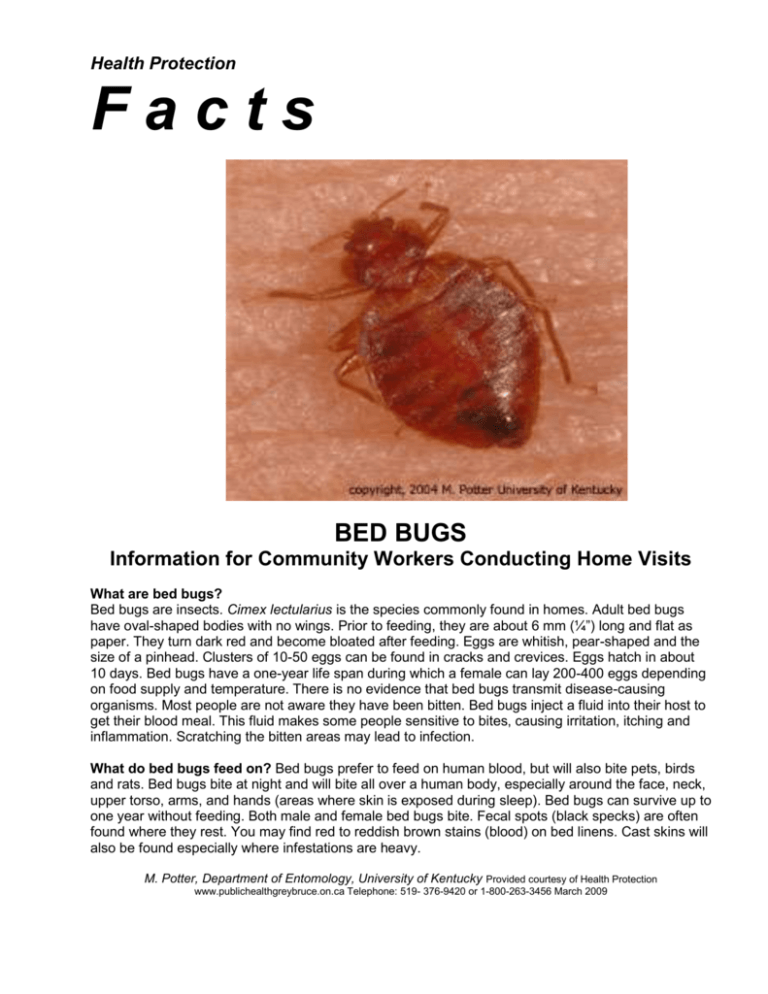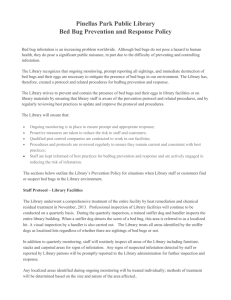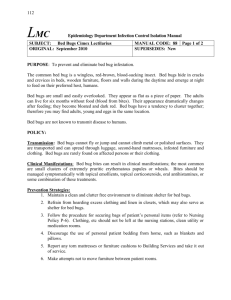Bed_Bug_Community_Fact_Sheet2
advertisement

Health Protection Facts BED BUGS Information for Community Workers Conducting Home Visits What are bed bugs? Bed bugs are insects. Cimex lectularius is the species commonly found in homes. Adult bed bugs have oval-shaped bodies with no wings. Prior to feeding, they are about 6 mm (¼”) long and flat as paper. They turn dark red and become bloated after feeding. Eggs are whitish, pear-shaped and the size of a pinhead. Clusters of 10-50 eggs can be found in cracks and crevices. Eggs hatch in about 10 days. Bed bugs have a one-year life span during which a female can lay 200-400 eggs depending on food supply and temperature. There is no evidence that bed bugs transmit disease-causing organisms. Most people are not aware they have been bitten. Bed bugs inject a fluid into their host to get their blood meal. This fluid makes some people sensitive to bites, causing irritation, itching and inflammation. Scratching the bitten areas may lead to infection. What do bed bugs feed on? Bed bugs prefer to feed on human blood, but will also bite pets, birds and rats. Bed bugs bite at night and will bite all over a human body, especially around the face, neck, upper torso, arms, and hands (areas where skin is exposed during sleep). Bed bugs can survive up to one year without feeding. Both male and female bed bugs bite. Fecal spots (black specks) are often found where they rest. You may find red to reddish brown stains (blood) on bed linens. Cast skins will also be found especially where infestations are heavy. M. Potter, Department of Entomology, University of Kentucky Provided courtesy of Health Protection www.publichealthgreybruce.on.ca Telephone: 519- 376-9420 or 1-800-263-3456 March 2009 How do bed bugs get into my home or apartment? Bed bugs are often carried into a home on objects, such as furniture and clothing. Bed bugs can be found in the following areas: • Seams, creases, tufts, and folds of mattresses and box springs • Cracks in the bed frame and head board • Under chairs, couches, beds, and dust covers • Between cushions of couches and chairs and between curtain folds • Under area rugs and the edges of carpets • In drawers, telephones, radios, and clocks • Behind baseboards and around window and door casings • Behind electrical plates and under loose wallpaper, paintings and posters • In cracks of plaster Health & Environment Facts Tips for Community Workers Doing Home Visits • Bed bugs are not a health hazard, they are considered a nuisance. Workers should be trained in recognizing the signs of a bed bug infestation. • Bed bugs are mainly active at night. They prefer to hide close to where they feed such as mattresses, cracks and crevices of bed frames and upholstered furniture. Bed bugs prefer wood, paper and fabric surfaces such as couches and upholstered chairs. These are areas to avoid during visits. • Be aware of where you place your belongings (e.g. coat, purse, scarves, and briefcase). Only bring the materials you will need for that visit into the home. If a house has an active bed bug infestation or if you are unsure of the status of an infestation, consider conducting the visit in the kitchen where non-upholstered furniture is less likely to be infested. • If you discover a bed bug infestation after you have entered the home, conduct a visual inspection of your belongings. To avoid transferring bed bugs, your belongings should be placed either on a previously inspected chair (with the clients permission) or positioned in an open area away from walls. Equipment should never be placed onto beds, on other furniture or next to walls. Upon exiting the home, place your belongings in a plastic bag for transport in your vehicle. Conduct a visual inspection of belongings and treat if required. • Infested clothing can be laundered in the hottest water possible (60◦C) and/or and place in a hot dryer for 30 minutes. These temperatures will kill all life cycle stages of bed bugs. Alternatively, materials may be placed in a freezer. The amount of time in the freezer depends on the size of the item, the larger the item the longer the time. If the freezer is at -20◦C, then 2 hours will be sufficient to kill all life cycle stages. However, for the average household freezer, more time may be needed. Dense items may take several days for the center to cool sufficiently to kill the bugs and the longer an item is kept frozen, the more likely the bugs will be destroyed. Role of Public Health The Public Health Unit provides information on how to identify bed bugs, how to prevent bringing bed bugs into the home and methods to control a bed bug infestation. The Public Health Unit does not visit a home to identify or confirm a bed bug infestation. Additional Recommendations for Community Groups Visual inspection of fleet vehicles and vacuuming of seats at end of day ? lockers at front entrance of OPSP/Hero for clients coats(separate coats from one another?) Encourage patients to launder clothing from second hand stores/Salvation Army etc (at least put in dryer) Info to clients re: what to look for when purchasing new furniture Discouraging patients from bringing in large number of belonging with admissions, community groups, etc. Consideration to purchase dryers?/Assist with funding for laundering items Assisting patients with laundering items/decreasing clutter/organizing belongings M. Potter, Department of Entomology, University of Kentucky Provided courtesy of Health Protection www.publichealthgreybruce.on.ca Telephone: 519- 376-9420 or 1-800-263-3456 March 2009








